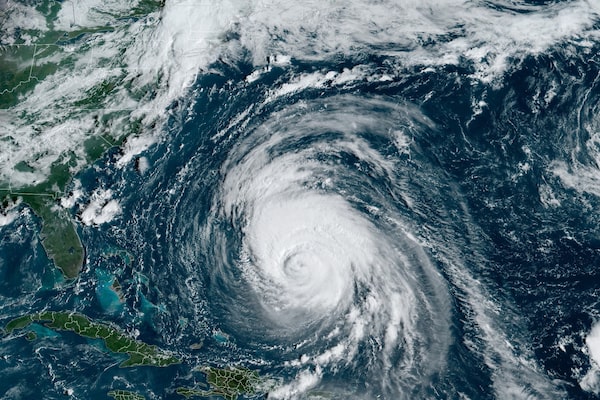A pedestrian walks along the empty waterfront as heavy rain falls in Halifax on Thursday, Sept. 14, 2023. Residents in Nova Scotia and New Brunswick are being told to prepare for strong winds and more heavy rain this weekend as post-tropical storm Lee is expected to make landfall.Darren Calabrese/The Globe and Mail
Maritimers spent Friday pulling their boats from the water and stocking up on propane, canned goods and yes, storm chips, to prepare for Hurricane Lee. The storm is expected to pummel the western coast of Nova Scotia and southern New Brunswick with near hurricane-force winds and heavy rain starting on Saturday morning.
The category one hurricane is expected to weaken into an intense post-tropical storm as it hits the coastal areas of both provinces, said Environment Canada, but meteorologist Bob Robichaud said Lee is still a very large storm that could hit at near hurricane strength, packing winds as high as 120 kilometres per hour along with heavy rainfall.
“We’re going to feel the impacts of this storm across the entire province,” Mr. Robichaud told reporters Friday afternoon.
The centre of the powerful storm will likely pass over southwestern Nova Scotia some time on Saturday afternoon, bringing Lee’s strongest winds and heaviest rainfall, he added.
Environment Canada expanded its hurricane watch in place for Grand Manan Island and coastal Charlotte County, N.B., and the Nova Scotia counties of Digby, Shelburne, Yarmouth and Queens, all the way up the Atlantic coast to Halifax and the Eastern Shore. It also issued storm-surge warnings for the entire Atlantic coast of mainland Nova Scotia, particularly around high tide, in the morning and evening on Saturday.
New Brunswick Premier Blaine Higgs warned residents to have enough food, medicine and other supplies to last them 72 hours. “Do not put yourselves in harm’s way. And caution others, certainly, to do the same,” he said Friday afternoon during a hurricane briefing.

This satellite image provided by CSU/CIRA-NOAA shows then-hurricane, now post-tropical storm Lee in the Atlantic Ocean on Wednesday, Sept. 13, 2023.The Canadian Press
On the southwest shore of Nova Scotia, fisherman Leroy d’Entremont, 58, of Pubnico spent the day fixing windows on his shed and moving his 58-foot fishing boat to a protected location away from the storm surge.
“I don’t remember being this close to a hurricane, but we have winter storms here that bill more than this hurricane is forecast to,” he said.
“Some people go get extra food – I have a garden and my freezer and I have animals so I could spend a month here without having to go to the store and buy food.”
Jennifer Chandler, commodore at the Chester Yacht Club, said many people have been taking their boats out of the water over the past several days. “We’ll be lashing down a lot of the gear. We’ve already taken all the furniture off our deck,” she said.
In Halifax, boat owners also rushed to protect their vessels. At the Nova Scotia Royal Yacht Squadron, clients were advised to double up their lines, point the bow of the boats toward the wind and move vessels from moorings into the marina, said communications and membership manager Callie MacDonald.
People stocked up on batteries and flashlights at Canadian Tire while queues at grocery stores wound dozens of people deep. Trulee Love and Bria Oswald, 23-year-old Dalhousie University students, carried armfuls of storm chips, muffins, wraps, veggies and cans of tuna – food that doesn’t need to go in the fridge – to prepare for the storm.
“We’re probably going to lose power,” said Ms. Love, an Alberta resident who has lived through two hurricanes over the past several years in Nova Scotia.
Storms chips became a bad-weather staple in Atlantic Canada during hurricane season in 2014, when a popular local radio show host mentioned them on air, prompting the social-media hashtag #stormchips and photos of cleared out chip aisles ahead of inclement weather.
At a provincial press conference Friday, Nova Scotia Power’s senior director of energy delivery said the company is most concerned with high winds knocking down trees onto power lines in Digby, Yarmouth and Shelburne.
“We’re premobilizing all of our crews,” said Matt Drover, adding that contractors have been brought in from other provinces. “They’ll be spread throughout the entire province but definitely the majority of people will be down in the western part, ready to respond to power outages as soon as they occur.”
Following the deadly flash flood in the province in July, and a near two-hour delay in issuing an emergency alert, the Nova Scotia government is reviewing how the emergency alert system was used. The issue of dead cellphone zones remains a public safety issue nearly two months after provincial and federal politicians vowed to fix the problem.
On Friday, a spokesman for François-Philippe Champagne, the federal minister responsible for the CRTC, wrote in a statement to The Globe that he has brought major telecommunications companies together and directed them to develop a memorandum of understanding on telecommunications reliability that includes provisions on emergency roaming, mutual assistance among providers and improving public awareness around telecommunications emergencies.
“The government will continue to work with telecommunications companies and its partners while using all the tools at its disposal to improve the reliability of Canada’s telecom networks,” wrote Justin Simard.